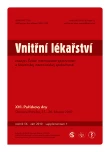The strategy of laboratory diagnostics and differential diagnostics of thrombocytopenia
Authors:
M. Kušnierová; P. Kessler
Authors‘ workplace:
Oddělení hematologie a transfuziologie Nemocnice Pelhřimov, p. o., přednosta prim. MU Dr. Petr Kessler
Published in:
Vnitř Lék 2010; 56(Supplementum 1): 104-108
Category:
16th Parizek's Days, Ostrava-Poruba, March 25th –26th 2010
Overview
Thrombocytopenia is a pathological state characterized by decreased platelet count under the lower limit of the physiological range, i.e. 150 × 109 per liter. This disorder can be associated with clinical manifestation of the hemorrhagic diathesis. The risk of bleeding is closely associated with the depth of platelets count decrease. Spontaneous bleeding (in absence of any other coagulation disorder) usually occurs when the platelet count decreases below 20 × 109 per liter. The first step, which should be done, when a newly diagnosed thrombocytopenia occurs, is a thorough review of a blood smear. Firstly, it is necessary to exclude the pseudothrombocytopenia, caused by an abnormal in vitro aggregation of thrombocytes, or (much less frequently) by platelet satelitism. It is also necessary to evaluate the red and white cells, especially to focus on the presence of schistocytes or blasts. Thereafter it is recommended to follow a standard diagnostic algorithm, which should be available in every hematological laboratory.
Key words:
laboratory diagnostics – thrombocytopenia – pseudothrombocytopenia
Sources
1. Kubisz P et al. Hematologia a transfuziologia. Praha: Grada Avicenum 2006.
2. Guidelines on the Diagnosis and Management of the Thrombotic Microangiopathic Haemolytic Anaemias. Br J Haematol 2003; 120: 556–577.
3. Penka M, Bulikova A et al. Neonkologická hematologie, 2. doplněné a zcela přepracované vydání, Praha: Grada Publishing 2009, 107 s.
4. Elting LS, Rubenstein EB, Martin CG et al. Incidence, cost and outcomes of bleeding and chemoterapy dose modification among solid tumor patients with chemoterapy – induced trombocytopenia. J Clin Oncol 2001; 19: 1137–1146.
5. Colman RV, Hirsch J et al. Diagnosis of the Immune thrombocytopenic purpura. Hemostasis and Thrombosis 1994; 117: 1713–1721.
6. Shanafelt TD, Fonseca R. Thrombocytopenia. In: Oliveira GHM, Nesbit GC, Murphy JG Mayo Clinic Medical Manual, Mayo Clinic Scientific Press 2006.
7. Mant MJ, Doery JC, Gauldie J et al. Pseudothrombocytopenia due to platelet aggregation and degranulation in blood collected in EDTA. Scand J Haematol 1975; 15: 161–170.
8. Payne BA, Pierre RV. Pseudothrombocytopenia a laboratory artefact with potentially serious consequences. Mayo Clin Proc 1984; 59: 123–125.
9. Drachman JG. Inherited thrombocytopenia: when a low platelet count does not mean MP. Blood 2004; 103: 390–398.
10. Hull RD, Pineo GF, Rashob GE. Hirudin versus heparin and LMWH. J Lab Clin Med 1998; 133: 171–174.
11. Becker JU. Disseminated Intravascular Coagulation: Differential Diagnosis. Br J Hematol 2007: 139: 387–415.
12. Taylor FBJ, Toh CH, Hoots WK et al. Towards definition, clinical and laboratory criteria, and a scoring system for disseminated intravascular coagulation. Tromb Haemost 2001; 86: 1327–1330.
13. Kelton J, Smith J, Warkentin T et al. Imunoglobulin G From Patients With Heparin-Induced Thrombocytopenia Binds to a Complex of Heparin and Platelet Factor 4. Blood 1994; 83: 3232–3239.
14. Koch S, Harenberg J, Odel M et al. Development of a High-Pressure Liquid Chromatography Method for Diagnosis of Heparin-Induced Thrombocytopenia. Am J Clin Pathol 2002; 117: 900–904.
15. Warkentin TE. Heparin-induced thrombocytopenia: diagnosis and management. Circulation 2004; 110: 454–458.
16. Young NS, Calado RT, Schering P. Current concepts in the pathophysiology and treatment of aplastic anemiae. J Blood 2006; 108: 2509–2519.
17. Thomas L. Clinical Laboratory Diagnostics. Value of Laboratory Testing 1998; 7: 1527.
18. Dunbar CE, Nienhuis AW. Myelodysplastic syndromes. Blood: Principles and practice hematology. J Blood 1995; 85: 377–414.
Labels
Diabetology Endocrinology Internal medicineArticle was published in
Internal Medicine

2010 Issue Supplementum 1
Most read in this issue
- Thrombocytopenia and coagulopathy in hepatopathy: an introduction into the issue
- Monitoring of coagulation parameters and options to influence them in patients with liver cirrhosis prior to invasive procedures
- Differential diagnosis of thrombocytopaenia in pregnancy
- The application of IPF (Immature platelet fraction) in laboratory diagnostics
